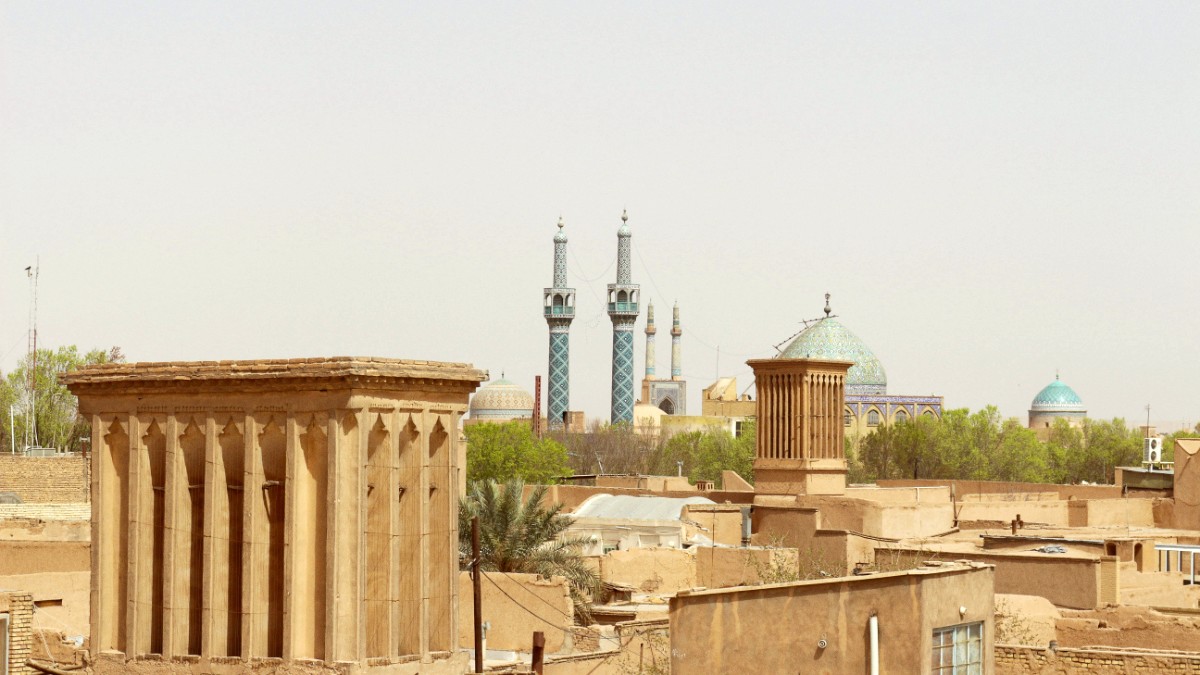
Iran
For thousands of years, people have lived and thrived here, using ingenuity to adapt to a challenging environment. Yazd offers a glimpse into an enduring Persian civilization, where ancient Zoroastrian traditions mix with Islamic heritage. It is a city that provides a deep connection to Iran's past and present, promising a journey filled with wonder and discovery. Prepare to be charmed by its warmth, captivated by its unique beauty, and inspired by its resilience.
The city’s architecture is a direct response to its arid setting. The famous windcatchers, or badgirs, are tall, chimney-like structures designed to capture even the slightest breeze and funnel it into buildings, providing natural air conditioning.
Mudbrick is the main building material, chosen for its insulating properties, which keep interiors cool in summer and warm in winter. The narrow, winding alleys of the old city also play a part, creating shade and directing airflows. These design choices create a microclimate that makes life possible and comfortable in a region of extreme temperatures. The city is a living example of how humans live in harmony with a demanding natural environment. Its isolation also helped preserve its unique character through centuries of change.
Yazd is a special place in Iran's long history. It is one of the oldest continually inhabited cities in the country, with origins stretching back over 3,000 years. Its strategic position on the ancient Silk Road made it a significant trading post, connecting East and West. Merchants, scholars, and travelers passed through its gates, contributing to its cultural richness.
The city was a prominent center for Zoroastrianism, a monotheistic religion predating Islam in Iran. Even today, Yazd remains a stronghold for the Zoroastrian community, with a functioning fire temple housing a flame said to have burned for over 1,500 years, and the ancient Towers of Silence on its outskirts. Marco Polo, the famous Venetian explorer, visited Yazd in 1272. He described it as a "good and noble city," noting its thriving silk trade. This observation highlights the city's importance as a center for commerce and craftsmanship centuries ago.
During the tumultuous Mongol invasions, Yazd largely escaped the widespread destruction that afflicted many other Persian cities. Its remote desert location and strong fortifications protected it.
This preservation led to its unique desert architecture, including its signature windcatchers, qanats, and mudbrick houses, surviving largely intact.
This architectural heritage is a testament to its adaptation to a harsh desert environment.
The historical city of Yazd was recognized and inscribed as an UNESCO World Heritage Site in 2017.
The city’s history is visible everywhere, from its ancient walls to its bustling bazaars, depicting a continuous narrative of human ingenuity and survival.
Yazd combines historical depth with a welcoming atmosphere, offering a deep dive into Iran's distinctive desert culture. Its ancient roots, ingenious architecture, and preserved heritage create a journey filled with wonder.
The historical core, an UNESCO World Heritage Site, presents an immersive experience of traditional desert urban planning. Its unique texture and color are unmistakable.
It is an unique place to experience both Islamic and pre-Islamic Iranian religious traditions, offering a profound cultural journey.
Yazd invites you to explore its unique blend of history, culture, and adaptive architecture.
Here is a quick look at Yazd, giving you facts before your visit:
Approx 530,000 within the metropolitan area (2023 estimate). The city is large enough to offer modern conveniences yet retains a relaxed, traditional atmosphere, specifically in its older sections.
Persian (Farsi) is the official language. While younger generations and those working in tourism speak some English, learning a few basic Persian phrases will ease interactions and show respect for local culture. Many signs, especially in the Old City, are in Persian, so a Translation app can be useful.
The population is predominantly Shia Muslim. Yazd is also remarkable for its significant Zoroastrian minority, making it an unique place to experience both Islamic and pre-Islamic Iranian religious traditions.
Essential information at a glance to help you plan.
Mild temperatures ideal for sightseeing and desert excursions. Expect comfortable exploration.
Fewer tourists and potentially lower prices. Weather is relatively pleasant but less predictable.
Significant discounts on accommodation and tours. Extreme heat in summer or cold winters.
The official currency is Iranian Rial (IRR), but prices are often in Tomans (1 Toman = 10 Rials). International credit/debit cards do not work due to sanctions. Carry sufficient USD or EUR in new, crisp bills. Exchange at official Sarafis for better rates.
Budget Traveler: €22-€55 (hostel/basic guesthouse, local food, public transport). Mid-Range Traveler: €60-€135 (comfortable guesthouse, mid-range restaurants, private taxis). Luxury Traveler: €150+ (boutique hotels, fine dining, private driver).
Negotiate taxi fares or use Snapp. Eat at local eateries. Utilize public transportation. Stay in guesthouses with breakfast. Manage your cash, dividing it and keeping some in a secure Money belt.